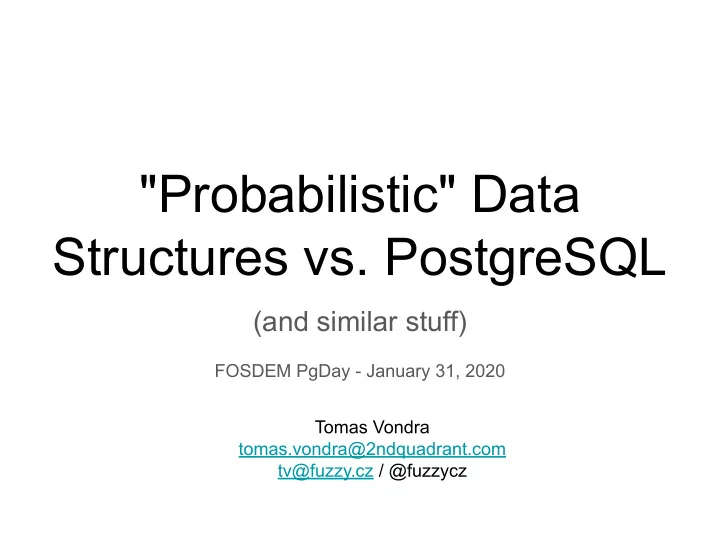

"Probabilistic" Data Structures vs. PostgreSQL (and similar stuff) FOSDEM PgDay - January 31, 2020 Tomas Vondra tomas.vondra@2ndquadrant.com tv@fuzzy.cz / @fuzzycz
HyperLogLog and t-digest
Probabilistic data structures ... use hash functions to randomize and compactly represent a set of items. These algorithms use much less memory and have constant query time … and can be easily parallelized. https://dzone.com/articles/introduction-probabilistic-0
https://en.wikipedia.org/wiki/Category:Probabilistic_data_structures ● Bloom Filter (set membership) ● HyperLogLog (count distinct) ● Count-Min Sketch (frequency table) ● MinHash (set similarity) ● … ● … random trees, heaps, ...
https://en.wikipedia.org/wiki/Category:Probabilistic_data_structures ● Bloom Filter (set membership) ● HyperLogLog (count distinct) ● Count-Min Sketch (frequency table) ● MinHash (set similarity) ● … ● … random trees, heaps, ...
access_log CREATE TABLE access_log ( ... req_date TIMESTAMPTZ, user_id INTEGER, response_time DOUBLE PRECISION, ... ); CREATE TABLE access_log (req_date timestamptz, user_id int, response_time double precision); INSERT INTO access_log SELECT i, 1000000 * random(), 1000 * random() from generate_series('2019-01-01'::timestamptz, '2020-02-01'::timestamptz, '1 second'::interval) s(i);
SELECT COUNT(DISTINCT user_id) FROM access_log
COUNT(DISTINCT user_id) ● has to deduplicate data ● needs a lot of memory / disk space ● … so it's slow ● difficult to precalculate ● difficult to compute incrementally ● difficult to parallelize
HyperLogLog
HyperLogLog ● when it's enough to have (accurate) estimate SELECT COUNT(DISTINCT user_id) FROM access_log; ● we'll observe number of zeroes at the beginning of the hash value 1xxxxxxxx => 1/2 ○ 01xxxxxxx => 1/4 ○ ○ … 0000001xx => 1/128 ○ ● Maximum number of zeroes we've seen is 6. What's the cardinality?
HyperLogLog value h1(value) 0 256 7 HLL prefix zeroes in h2(value)
HyperLogLog 0 256 5 3 4 7 5 6 ... HLL ... 6 4 5 8 5 4 harmonic mean + correction
https://github.com/citusdata/postgresql-hll
Alternative to COUNT(DISTINCT user_id) -- install the extension CREATE EXTENSION hll; -- generate HLL counter from user_id values SELECT hll_add_agg (hll_hash_integer(user_id)) FROM access_log; -- estimate the cardinality of user_id values SELECT # hll_add_agg(hll_hash_integer(user_id)) FROM access_log;
Rollup (pre-calculation) -- create a rollup table CREATE TABLE access_log_daily (req_day date, req_users hll ); -- pre-calculate daily summaries INSERT INTO access_log_daily SELECT date_trunc('day', req_date), hll_add_agg (hll_hash_integer(user_id)) FROM access_log GROUP BY 1;
Rollup (pre-calculation) -- use the rollup to summarize range SELECT #hll_union_agg (req_users) FROM access_log_daily WHERE req_day BETWEEN '2019-10-01' AND '2019-10-08';
HyperLogLog ● 2007 (evolution from ~1990) ● just an estimate, not an exact cardinality ○ but you can compute the maximum error ● trade-off between size and accuracy ○ size grows very slowly (with increasing accuracy / number of values) ○ 6kB more than enough for 1B values with 1% accuracy (1.5kB - 2% etc.) ● supports ○ precalculation (rollup) ○ incremental updates ○ ...
t-digest
percentile_cont / percentile_disc SELECT percentile_cont(0.95) WITHIN GROUP (ORDER BY response_time) FROM access_log
percentile_cont / percentile_disc SELECT percentile_cont(ARRAY[0.95, 0.99]) WITHIN GROUP (ORDER BY response_time) FROM access_log
percentile_cont / percentile_disc ● accurate results ● has to store and sort all the data ● difficult to parallelize ● can't be precalculated :-(
t-digest ● published in 2013 by Ted Dunning ● approximation of CDF (cumulative distribution function) ● essentially a histogram ○ represented by centroids, i.e. each bin is represented by [mean, count] ○ requires data types with ordering and mean ● intended for stream processing ○ but hey, each aggregate is processing a stream of data ● higher accuracy on the tails (close to 0.0 and 1.0)
0 1000
0 1000
80% 0 1000
95% 0 1000
95% 0 1000
99% 0 1000
0 1000
0 1000
https://github.com/tvondra/tdigest
Trivial example SELECT percentile_cont(0.95) WITHIN GROUP (ORDER BY response_time) FROM access_log SELECT tdigest_percentile (response_time, 100, 0.95) FROM access_log
Precalculation CREATE TABLE precalc_digests ( req_day date, req_durations tdigest ); INSERT INTO precalc_digests SELECT date_trunc('day', req_date), tdigest (response_time, 100) FROM access_log GROUP BY 1;
t-digest ● modus operandi similar to HyperLogLog ○ approximation by simpler / smaller data structure ○ incremental updates ○ possibility to precalculate + rollup ● result depends on order of input values ○ affects parallel queries ● no formal accuracy limits ○ better accuracy on tails ○ worse accuracty close to 0.5 (median)
?
Recommend
More recommend